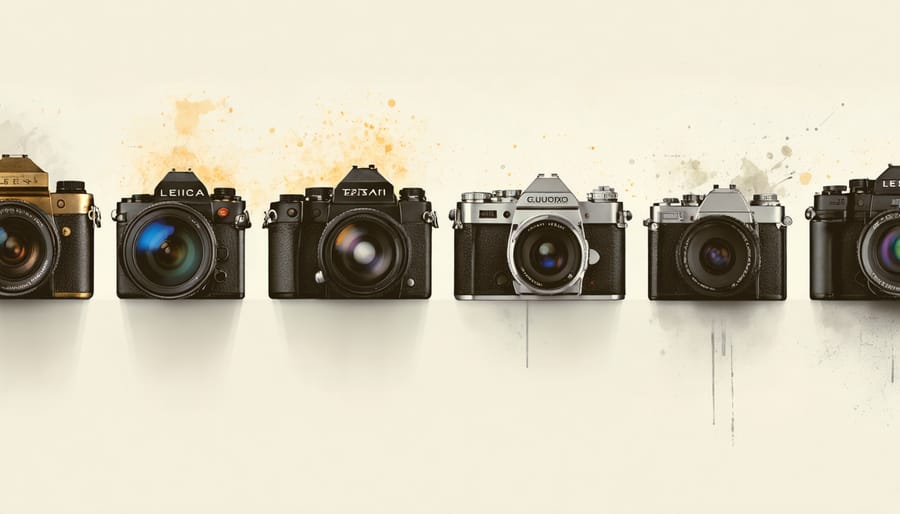
Every lens tells a story through its unique combination of focal length, aperture, and optical design – elements that have transformed photography forever. From the humble beginnings of simple glass elements to today’s sophisticated multi-element designs, camera lenses remain the photographer’s most crucial creative tool.
Understanding lens fundamentals unlocks a world of creative possibilities that extend far beyond basic picture-taking. While a camera body captures the image, it’s the lens that shapes how we see the world – determining everything from the frame’s perspective to the quality of bokeh that makes subjects pop from their backgrounds.
Whether you’re shooting with vintage manual focus primes or the latest autofocus zooms, the core principles of focal length, aperture, and optical design remain unchanged. These fundamentals form the foundation of every photographic decision, from selecting the perfect portrait lens to capturing sweeping landscapes that take viewers’ breath away.
In this comprehensive guide, we’ll decode the technical aspects of camera lenses while keeping things practical and approachable. You’ll learn not just what different lenses do, but why and when to use them – transforming complex optical concepts into creative tools you can use to elevate your photography immediately.
The Birth of Photographic Lenses
Daguerreotype Era Lenses
The story of photographic lenses begins with the daguerreotype era, marking a revolutionary period when the first purpose-built photographic lenses emerged. In 1839, Charles Chevalier designed the first lens specifically for Louis Daguerre’s groundbreaking process, laying the foundation for many old photography techniques we still reference today.
These early lenses were relatively simple double-element designs, featuring two pieces of glass that worked together to focus light onto the photosensitive plate. The most notable advancement came from Josef Petzval in 1840, whose innovative lens design dramatically reduced exposure times from several minutes to just seconds. The Petzval portrait lens, with its distinctive bokeh and shallow depth of field, became the standard for portrait photography and continues to inspire modern lens makers.
What makes these pioneering lenses particularly fascinating is their enduring influence on contemporary photography. Despite their technological limitations, they produced images with unique characteristics that many photographers still try to replicate. The soft focus, dramatic fall-off, and dreamy bokeh of daguerreotype-era lenses have become sought-after effects, with some modern manufacturers even creating new lenses that deliberately incorporate these “imperfections” into their design.
These early innovations laid the groundwork for all subsequent lens development, teaching us that sometimes the most beautiful images come from embracing technical limitations rather than pursuing absolute perfection.
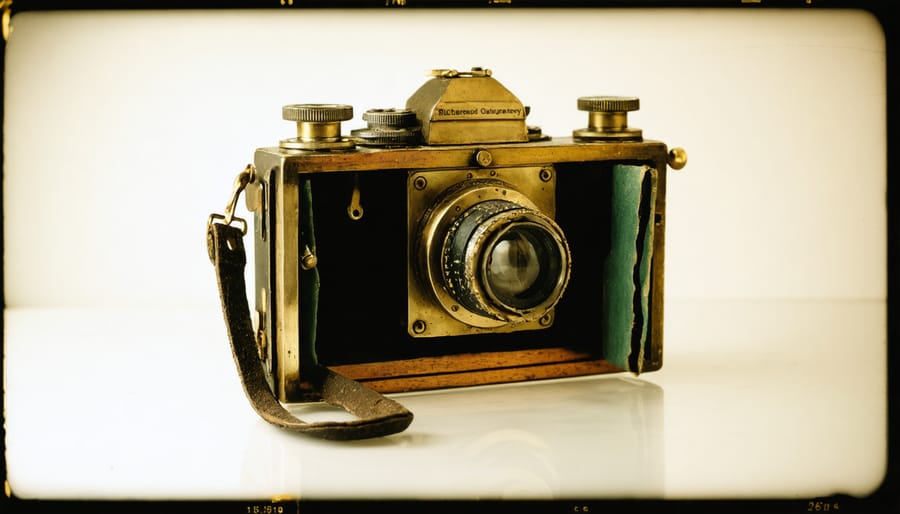
Petzval’s Revolutionary Design
In 1840, mathematician Joseph Petzval introduced a lens design that would revolutionize portrait photography and influence optical engineering for generations to come. The Petzval portrait lens featured a unique construction with four elements in two groups, creating what photographers would come to cherish as the “Petzval effect” – sharp central focus with a dreamy, swirling bokeh in the background.
What made Petzval’s design truly groundbreaking was its impressive f/3.6 aperture, remarkably fast for its time. This allowed for shorter exposure times, making studio portraits more practical and comfortable for subjects. The lens captured images with a characteristic glow and three-dimensional pop that became highly sought after by portrait photographers of the Victorian era.
Though modern lenses have largely moved away from Petzval’s exact design, its influence persists. Contemporary manufacturers have released new interpretations of the Petzval lens, catering to photographers seeking its distinctive artistic rendering. The characteristic swirling bokeh and center-weighted sharpness continue to inspire creative portrait work, especially in fine art and fashion photography.
The Petzval design teaches us an important lesson about lens development: sometimes “imperfections” can become desirable artistic tools. While modern lenses strive for edge-to-edge sharpness and minimal distortion, the Petzval reminds us that character and artistic rendering can be just as valuable as technical perfection.
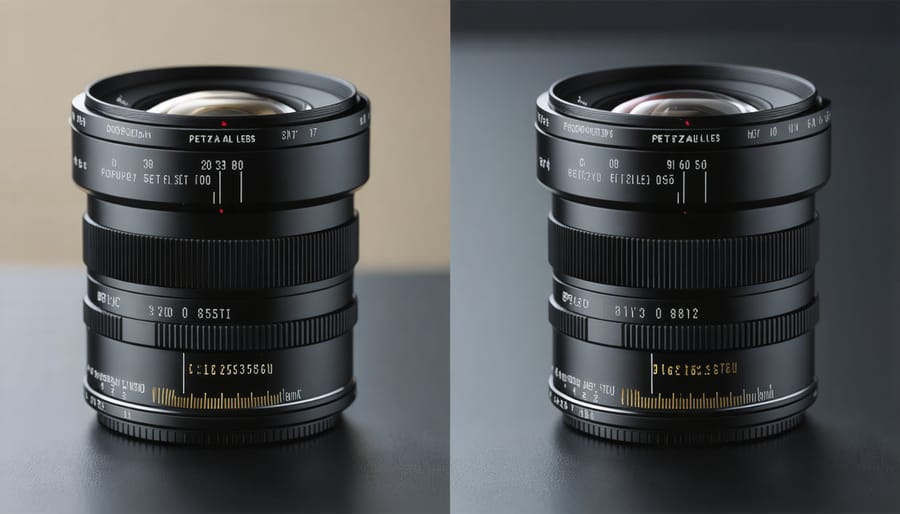
The Golden Age of Manual Lenses
German Engineering Excellence
When discussing the evolution of camera lenses, no conversation is complete without acknowledging the profound impact of German engineering, particularly through the innovations of Zeiss and Leica. These manufacturers, deeply rooted in historic photo processes, have consistently pushed the boundaries of optical excellence.
Carl Zeiss’s contributions to lens design revolutionized photography in the early 20th century. The company’s Tessar design, introduced in 1902, became known as the “eagle eye” for its exceptional sharpness and clarity. This four-element lens design continues to influence modern optics, showcasing how foundational innovations can stand the test of time.
Leica, under the guidance of Oscar Barnack, transformed photography by pioneering the 35mm format. Their early M-mount lenses set new standards for precision and optical quality. The legendary Leica Summicron 50mm f/2, first introduced in 1953, remains a benchmark for lens performance, demonstrating the enduring quality of German engineering principles.
What sets these manufacturers apart is their unwavering commitment to precision. Both companies maintain strict quality control standards, with many lens elements still ground and polished by hand. This attention to detail results in lenses that consistently deliver superior image quality, micro-contrast, and that indefinable quality photographers often describe as “rendering” or “drawing.”
Modern Zeiss and Leica lenses continue this tradition of excellence, incorporating contemporary innovations while maintaining their classical optical formulas. The Zeiss Otus series and Leica APO-Summicron-M lines represent the pinnacle of what’s possible in lens design, offering uncompromising performance for today’s high-resolution sensors.
For photographers seeking the ultimate in image quality, these German-engineered lenses offer something special: a perfect blend of technical precision and artistic character that has been refined over generations of optical innovation.
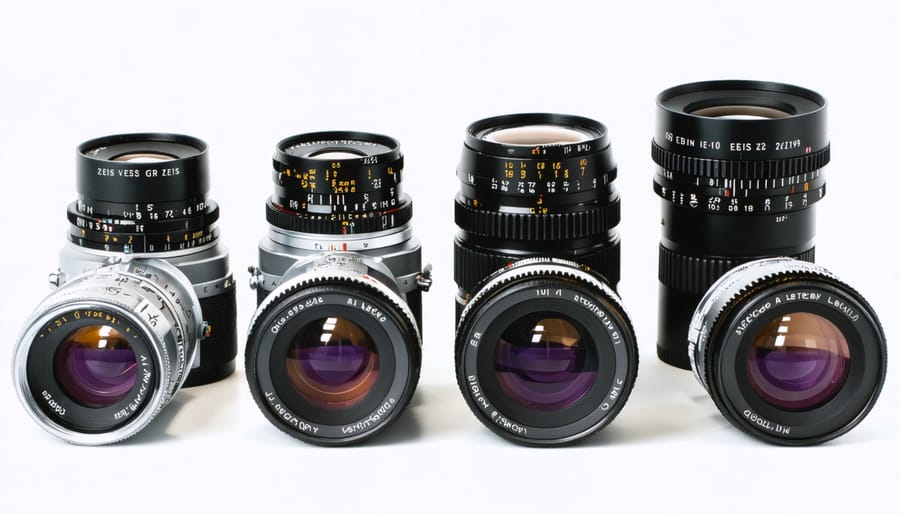
Japanese Lens Revolution
The post-World War II era marked a pivotal shift in photography when Japanese manufacturers revolutionized the lens industry. Companies like Nikon, Canon, and Pentax emerged from Japan’s economic recovery to challenge the European dominance of Zeiss and Leica, bringing unprecedented innovation and accessibility to photographers worldwide.
Japanese manufacturers introduced several game-changing approaches. First, they mastered the art of mass production while maintaining high quality standards, making premium optics available at more affordable prices. This democratization of quality lenses helped expand photography from an elite pursuit to a mainstream hobby and profession.
The 1950s and 1960s saw Japanese companies pioneer new optical designs and coating technologies. Nikon’s F-mount system, introduced in 1959, set new standards for lens interchangeability, while Canon’s FL and later FD series brought advanced features like full-aperture metering to the masses. These innovations weren’t just technical achievements; they fundamentally changed how photographers worked and created.
Perhaps most significantly, Japanese manufacturers excelled at listening to photographers’ needs and rapidly iterating their designs. This user-focused approach led to practical improvements like better ergonomics, weather sealing, and more reliable autofocus systems. They also standardized many features we take for granted today, such as zoom lenses with consistent maximum apertures throughout their range.
The Japanese lens revolution wasn’t just about manufacturing efficiency or technical innovation – it was about making professional-quality tools accessible to more photographers. This democratization of quality optics helped create the modern photography landscape we know today, where enthusiasts can access excellent lenses without breaking the bank, and professionals have a wide range of specialized tools at their disposal.
Today’s Japanese lens manufacturers continue this tradition of innovation, leading the way in mirrorless lens design and pushing the boundaries of what’s possible in optical engineering, while maintaining the balance between quality and accessibility that made them industry leaders in the first place.
Modern Interpretations of Classic Designs
Revival of Vintage Aesthetics
In recent years, there’s been a fascinating revival of vintage lens aesthetics, with manufacturers and photographers alike embracing the distinctive characteristics of classic glass. Modern lens makers are now deliberately engineering “imperfections” that photographers once tried to eliminate, creating optics that capture the warmth, softness, and unique flare patterns reminiscent of bygone eras.
Companies like Lensbaby, Meyer Optik Görlitz, and TTArtisan have introduced lenses that specifically recreate the dreamy, swirling bokeh of historic designs like the Petzval portrait lens. These modern interpretations maintain the beloved characteristics of their ancestors while incorporating contemporary manufacturing standards and mount compatibility.
What makes these vintage-inspired lenses special isn’t just their optical formula, but their ability to produce images with character. Where clinical sharpness and technical perfection define most modern lenses, these throwback designs embrace light falloff, gentle softness around the edges, and distinctive flare patterns that add emotional depth to images.
Portrait photographers particularly appreciate these lenses for their ability to render skin tones with a flattering softness while maintaining detail where it matters. The slightly lower contrast and subtle color rendering create a painterly quality that’s difficult to replicate with post-processing.
For videographers, vintage-style lenses have become go-to tools for creating period-appropriate looks or adding artistic flair to contemporary projects. The natural imperfections and characteristic aberrations help create an organic, cinematic feel that audiences associate with classic films.
Even photographers who typically shoot with the latest and sharpest glass often keep a vintage-inspired lens in their bag for creative projects. These lenses serve as valuable tools for breaking away from technical perfection and introducing intentional character into images, proving that sometimes the “flaws” of the past can become the creative features of the present.
Adapting Vintage Lenses
The world of vintage lenses offers photographers a unique opportunity to create distinctive images with character and soul. These classic pieces of glass, often decades old, can breathe new life into your digital photography when properly adapted to modern cameras.
To use vintage lenses on contemporary cameras, you’ll need lens adapters that bridge the gap between old lens mounts and your camera’s mounting system. The key is matching the correct adapter to both your camera’s mount type and the vintage lens mount. For instance, an old M42 screw-mount lens can be adapted to work on most modern mirrorless cameras.
While adapting vintage lenses often means sacrificing autofocus and automatic aperture control, many photographers find this limitation liberating. Manual focusing becomes an intentional part of the creative process, and the unique optical characteristics of vintage glass – including specific flare patterns, bokeh shapes, and color rendition – can add a distinctive aesthetic to your images that’s difficult to replicate with modern lenses.
Some popular vintage lens choices include the Helios 44-2 (known for its swirly bokeh), the Super-Takumar 50mm f/1.4 (celebrated for its warm rendering), and various Carl Zeiss designs that maintain their legendary sharpness decades later. When shopping for vintage lenses, look for copies with clear glass, smooth focus rings, and working aperture mechanisms.
Remember that adapting vintage lenses requires patience and practice. Start with slower-moving subjects while you master manual focusing, and experiment with different vintage options to find the characteristics that best suit your photography style. The investment in time and learning can result in uniquely beautiful images that stand out in today’s digital world.
Character vs Clinical Perfection
In the world of photography, there’s an ongoing artistic dialogue between the charm of vintage lenses and the precision of modern lens characteristics. While contemporary lenses offer incredible sharpness, minimal distortion, and near-perfect optical performance, many photographers deliberately choose older lenses for their unique character and imperfections.
Vintage lenses often produce images with distinctive qualities like subtle color rendering, pleasing bokeh patterns, and even intentional flaws that add personality to photographs. The swirly bokeh of the Helios 44-2 or the dreamy glow of old Leica lenses have become celebrated characteristics, sought after for their ability to create images with soul and storytelling power.
In contrast, modern lenses prioritize clinical perfection. They’re engineered to eliminate chromatic aberration, maintain corner-to-corner sharpness, and deliver consistent results in any shooting condition. This technical excellence is invaluable for commercial work, architecture photography, and situations where precision is paramount.
The choice between character and perfection isn’t about right or wrong – it’s about artistic vision. Many photographers maintain a collection of both vintage and modern glass, selecting their tools based on the creative requirements of each project. A fashion shoot might benefit from the ethereal qualities of a vintage portrait lens, while architectural documentation demands the geometric accuracy of contemporary optics.
Understanding this balance helps photographers make informed decisions about their gear, allowing them to choose lenses that align with their creative voice rather than simply chasing technical specifications.
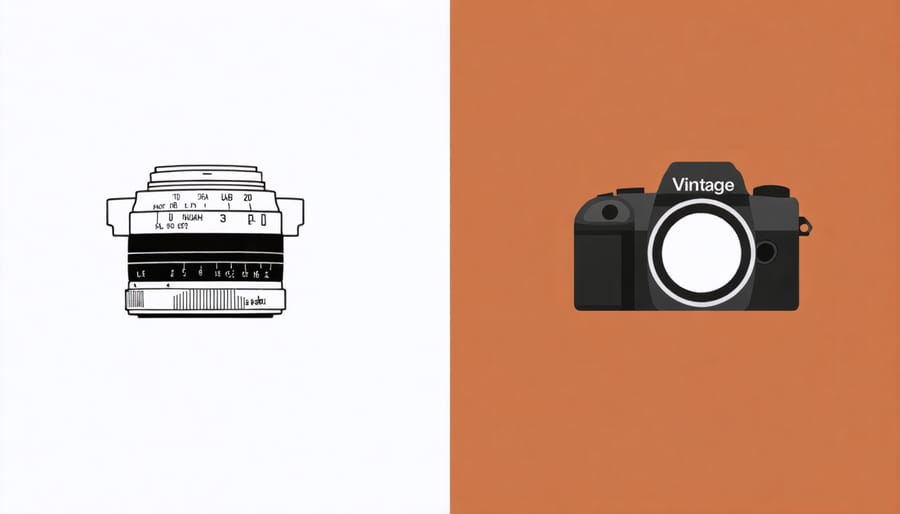
Future Through the Past
Photography’s past continues to shape its future in fascinating ways, particularly when it comes to lens design. Many of today’s most innovative lenses draw direct inspiration from classic optical formulas developed decades ago. The legendary Zeiss Planar design from 1896, for instance, remains a foundation for many modern standard lenses, prized for its exceptional sharpness and minimal distortion.
What’s particularly intriguing is how vintage lens characteristics are being deliberately incorporated into cutting-edge designs. The much-loved “swirly bokeh” effect of the Petzval lens, invented in 1840, has inspired a whole new generation of artistic portrait lenses. Modern manufacturers have found ways to tell stories through your lens by combining classical optical formulas with contemporary manufacturing techniques.
The double-Gauss design, dating back to 1817, continues to influence the development of 50mm lenses, offering that perfect balance of speed, sharpness, and natural perspective that photographers cherish. Even as we push the boundaries of what’s possible with modern materials and computer-aided design, these time-tested optical formulas remain remarkably relevant.
Contemporary lens makers are also revisiting historical “flaws” – such as chromatic aberration and field curvature – and selectively incorporating them as creative features. What was once considered imperfect is now being embraced for its unique artistic qualities, leading to hybrid designs that blend vintage character with modern precision.
Looking ahead, we’re seeing an exciting convergence of old and new. Manufacturers are developing “smart” lenses that combine classical optical designs with advanced electronics, allowing photographers to switch between modern clinical sharpness and vintage-inspired rendering at will. This fusion of historical wisdom with cutting-edge technology suggests that the future of lens design will continue to be shaped by the ingenious solutions of the past.
The legacy of historical lens designs continues to shape modern photography in profound ways. From the Petzval portrait lens of the 1840s to the revolutionary Double Gauss design, these pioneering optical formulas remain the foundation upon which today’s sophisticated lenses are built. Many contemporary photographers are even returning to vintage lens designs, seeking the distinctive character and imperfections that create unique visual signatures in their work.
The principles discovered by early optical pioneers like Carl Zeiss and Ernst Abbe continue to influence how we approach lens design today. The Cooke Triplet formula, for instance, still serves as the basis for many modern prime lenses, while the Tessar design’s efficiency makes it relevant for smartphone cameras. Even as computational photography and advanced manufacturing techniques push the boundaries of what’s possible, these historical designs provide the essential framework for understanding optical behavior and image formation.
As we look to the future of photography, these classical designs remind us that great optics are about more than just technical perfection – they’re about creating tools that serve both the practical and artistic needs of photographers.






















